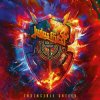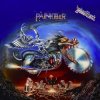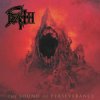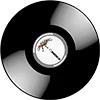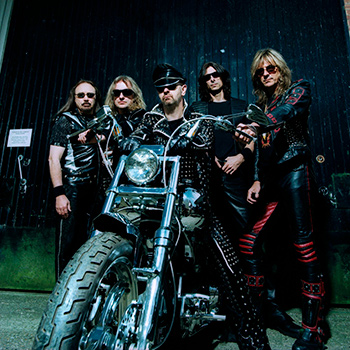
Judas Priest — a British heavy metal band from Birmingham and one of the genre’s cornerstones. Alongside Black Sabbath, Deep Purple, Led Zeppelin, and Uriah Heep, the group shaped the sound of 1970s hard rock and then spent decades expanding its vocabulary — from anthemic heavy to high-velocity speed/power and modern arena metal. Over their career, the band has sold around 50 million records worldwide and in 2022 was inducted into the Rock & Roll Hall of Fame. Their “code”: dual lead guitars, a “steel” image, the dramaturgy of stadium anthems, and the unique vocal range of Rob Halford.
Formation and early years (1969–1975)
The story begins with school friends from industrial Birmingham — guitarist K.K. Downing and bassist Ian Hill, united by a passion for guitar music from blues to psychedelia. An early lineup with vocalist Al Atkins and a carousel of drummers sought a “progressive blues” language, gigging heavily in Midlands and London pubs and clubs while living on the edge. The turning point came when, through his girlfriend’s sister, Hill met young vocalist Rob Halford (and his drummer John Hinch). In 1974 the Gull label required a second lead guitarist — enter Glenn Tipton (ex–The Flying Hat Band). Thus was born the formula of two equal lead guitars, which became an industry standard.
The debut Rocka Rolla (1974) was recorded with producer Rodger Bain (Black Sabbath). The record sounded softer than the live set, but laid the foundation: the Downing/Tipton tandem, Halford’s melodic instinct, and a drive toward a heavy sound with clear songcraft.
Finding the “classic metal” voice (1976–1979)
Sad Wings of Destiny (1976) forged the recognizable DNA: dueling harmonized leads, rolling riffing, Halford’s range from baritone to falsetto, and a dark theatricality. A CBS deal moved the band into the “top flight”: session ace Simon Phillips then Les Binks on drums, and producer Roger Glover on Sin After Sin (1977). On Stained Class (1978) you hear the proto-speed/thrash blueprints (see “Exciter”). Killing Machine (US: Hell Bent for Leather, 1978) tightened the song forms and established Halford’s leather-and-studs look as heavy metal’s visual code. The live set Unleashed in the East (1979) cemented their reputation as one of the late-’70s’ finest live machines.
Mainstream breakthrough: the razor of anthems (1980–1984)
British Steel (1980) is a watershed album that pulled heavy into radio without losing weight: “Breaking the Law,” “Living After Midnight,” “Metal Gods.” Point of Entry (1981) chased a more “American” sound, but Screaming for Vengeance (1982) restored and amplified the power — “You’ve Got Another Thing Comin’” hit MTV and the album went platinum in the U.S. Defenders of the Faith (1984) perfected the “aggression + melody” formula of arena metal.
Experiment and tempering (1986–1989)
Turbo (1986) gambled on guitar synths and a pop sheen — divisive among purists, but ambitious in production and staging (Fuel for Life). Ram It Down (1988) brought back weight and speed; at tour’s end drummer Dave Holland left, replaced by Scott Travis, whose double-kick attack became the spine of the next era.
Speed-metal canon at major-label scale — and crisis (1990–1992)
Painkiller (1990) was a “metal renaissance”: Travis’s jet-drive, razor riffs, Halford’s sky-high register. In parallel came a grueling U.S. court case over alleged “subliminal messages”; the charges were dismissed, but nerves and resources were drained. In 1992 Rob Halford announced the side project Fight and departed Judas Priest.
The “Ripper era” (1996–2003)
After a long search, American singer Tim “Ripper” Owens — famed for a Judas Priest tribute set — took the mic. Jugulator (1997) and Demolition (2001) showcased the band’s alternative-heavy side — lower tunings, groove, and modern aggression. The label also reissued the back catalog, enshrining the “canon” of the classic years.
Reunion and second youth (2003–2017)
In 2003 Halford returned. Angel of Retribution (2005) celebrated the reunion with “big forms” and winks to the past. The double concept album Nostradamus (2008) expanded ambitions into symphonic metal and theatrical staging. In 2011 K.K. Downing exited; young virtuoso Richie Faulkner stepped in, injecting onstage rock energy and becoming Tipton’s writing partner. Anniversary tours, live releases, and new material restored the band’s relevance beyond nostalgia.
Modern bloom: Firepower and beyond (2018–present)
Firepower (2018) is a model late-era album: production by Tom Allom and Andy Sneap, nostalgia without retro patina, hit singles “Lightning Strike” and the title track. In 2018 Glenn Tipton publicly revealed his Parkinson’s diagnosis; he continues to record and occasionally appears for encores, while Sneap handles his parts live. The 50 Heavy Metal Years tour (with pandemic delays) confirmed the band’s form. In 2024 they released Invincible Shield — fast cuts and mid-tempo anthems with a sharp, contemporary sound; many critics ranked it alongside Priest’s best work of the 21st century.
Musical language and influence
-
Two lead guitars as “dialogue voices”: harmonized leads, countermelodies, synchronized riff units — a matrix for Iron Maiden, Helloween, Megadeth, and more.
-
Halford’s vocals — the benchmark dramatic tenor/falsetto in heavy metal; technique, range, and a commanding stage persona.
-
Image: leather, metal, studs, a motorcycle on stage — the genre’s visual grammar, replicated by thousands.
-
Rhythmics: from marching hooks (Breaking the Law) to speed-metal hurricanes (Painkiller).
-
Stylistic flexibility: Priest remained heavy at the core yet boldly folded in AOR touches, guitar synths, symphonic arrangements — without losing their “steel.”
Key moments and milestones (brief timeline)
-
1974–1978 — The “dueling” guitar formula takes shape; Sad Wings…, Stained Class, Killing Machine.
-
1979 — Live benchmark Unleashed in the East.
-
1980–1984 — Mainstream breakthrough: British Steel, Screaming for Vengeance, Defenders of the Faith.
-
1986–1988 — Experiments (Turbo), return to heaviness (Ram It Down), Scott Travis arrives.
-
1990 — Painkiller: speed-metal canon on a major scale.
-
1992–2003 — Halford’s departure; the “Ripper era.”
-
2005 — Reunion with Angel of Retribution.
-
2008 — Concept opera Nostradamus.
-
2011 — K.K. Downing leaves; Richie Faulkner joins.
-
2018 — Firepower; Glenn Tipton’s illness becomes public.
-
2022 — Rock & Roll Hall of Fame induction.
-
2024 — Invincible Shield.
Lineup
Current core lineup
-
Rob Halford — vocals (1973–1992; since 2003)
-
Glenn Tipton — guitar, keys (since 1974; on stage selectively since 2018)
-
Richie Faulkner — guitar (since 2011)
-
Ian Hill — bass (since 1970; ever-present member)
-
Scott Travis — drums (since 1989)
Touring member
-
Andy Sneap — guitar (since 2018; tours, covering Tipton live)
Notable former members
-
K.K. Downing — guitar (1970–2011)
-
Tim “Ripper” Owens — vocals (1996–2003)
-
Classic-years drummers: Les Binks (1977–1979), Dave Holland (1979–1989), and others.
Discography (key releases)
Studio albums (selected milestones):
Rocka Rolla (1974) • Sad Wings of Destiny (1976) • Sin After Sin (1977) • Stained Class (1978) • Killing Machine / Hell Bent for Leather (1978) • British Steel (1980) • Point of Entry (1981) • Screaming for Vengeance (1982) • Defenders of the Faith (1984) • Turbo (1986) • Ram It Down (1988) • Painkiller (1990) • Jugulator (1997) • Demolition (2001) • Angel of Retribution (2005) • Nostradamus (2008) • Redeemer of Souls (2014) • Firepower (2018) • Invincible Shield (2024)
Video/live: Unleashed in the East (1979, audio), Priest… Live! (1987), Rising in the East (2005), anniversary editions of British Steel and Live Vengeance ’82, and more.
10 tracks for a “quick entry”
Breaking the Law, Living After Midnight, Metal Gods, You’ve Got Another Thing Comin’, Electric Eye, Freewheel Burning, The Sentinel, Turbo Lover, Painkiller, Lightning Strike (and from the new era: Panic Attack).
Legacy
Judas Priest are architectural artists: they codified heavy metal’s sonic and visual grammar, set the gold standard for dual guitars, showed how heaviness can become a pop language without “dumbing down,” and proved in the 21st century (with Firepower and Invincible Shield) that classic heavy remains a living artistic tongue when spoken by a band with vision and character.
